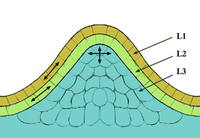
Photo from wikipedia
BACKGROUND Stimulating maize ear development is an effective way of improving yield. However, a limited information available the regulation of sink strength changed from weak to strong. Here, a novel… Click to show full abstract
BACKGROUND Stimulating maize ear development is an effective way of improving yield. However, a limited information available the regulation of sink strength changed from weak to strong. Here, a novel method for stimulating development combined with physiological assays and proteomics was applied to explore the regulation of ear strengthened development. RESULTS By blocking pollination of the upper ear of maize hybrid Suyu 41, the adjacent lower ear was dramatically stimulated at four days after pollination (DAP). Tandem mass tag (TMT)-based proteomics identified 173 differentially expressed proteins (fold change>1.2 or<0.83, p<0.05) from 7793 total proteins. Gene ontology (GO) annotations indicated that several pathways were noticeable changes with a preferential distribution to cell wall remodeling, hormone signals, and lipid metabolism in the stimulated kernels. Cell wall remodelling was highly mediated by chitinase, exhydrolase II, and xyloglucan enotransglucosylase/hydrolase, and accompanied by increased sucrose and glucose contents. A series of lipoxygenase proteins were significantly up-regulated, causing a significant alteration in lipid metabolism. Hormone signals were influenced by the expression of the proteins involved in IAA transport, ZT biosynthesis, and ABA signal response, and the increased IAA, ZT, and ABA contents. CONCLUSION The critical time for understanding the mechanism by which ear growth is stimulated is 4 DAP. Comparative proteomics and physiological analysis revealed that lipid metabolism enhancement, cell wall remodeling, and changes in hormone signaling (IAA, ZT, and ABA) were all important in stimulating early ear development. Proper regulation of these pathways may improve ear development, resulting in increased maize yield. This article is protected by copyright. All rights reserved.
Journal Title: Journal of the science of food and agriculture
Year Published: 2022
Link to full text (if available)
Share on Social Media: Sign Up to like & get
recommendations!